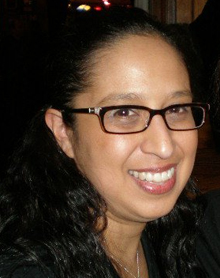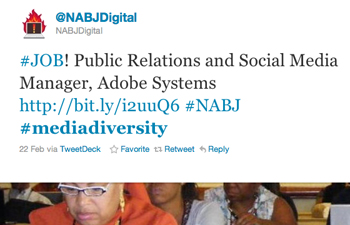PBS.org has recently been home to some frank and thoughtful discussions about an overlooked issue: the lack of racial diversity in the media.
For those who may have missed it, the dialogue was sparked by Retha Hill in an Idea Lab post about the lack of minorities at new media conferences. Mark Glaser expanded the conversation from the comments section to a wider audience on Twitter with a MediaShift #mediadiversity chat. And Hill has followed up with a post on the need for media innovation in minority communities.
All this got me thinking about my particular media niche: technology public relations. What’s so special about tech PR? Well, for those loosely familiar with the PR sector, imagine it as music. Entertainment, fashion, beauty and sports PR are akin to pop music.
Tech PR is more like opera. It requires a slightly different set of skills and media approaches. How many people of color in opera can music-lovers name? Aside from the great Kathleen Battle, not many come to mind. Unfortunately, this dilemma also rings true for tech PR. Persons of color are an untapped market that many PR agencies have not yet explored. Looking back at my six years in PR, I can count the number of brown colleagues I’ve worked with on less than two hands.
Why are minorities — especially those of black and Latino descent — largely missing from the tech media landscape? Inspired by this new-found dialogue on diversity in media, I want to talk about my career as a publicist representing and working with digital media and technology companies and offer some suggestions for remedying the tech PR industry’s diversity deficit.
How I got here
When I was about 12 years old, I accompanied my father, who is a professor, to a wrap party for a film project where he served as an academic advisor. At the celebration, I remember one of the producers telling me that I’d be “good at PR” when I grew up. Back then, I didn’t know what the producer meant. But that seed of advice remained in the back of my mind as I graduated from Rutgers College (part of Rutgers, the state university of New Jersey), studied and lived abroad in Europe and Brazil, and completed a master’s program in marketing from the Bristol Business School in Bristol, England.

Upon finishing my master’s program, I gravitated back to where my friends and family are from — New York City, the so-called Silicon Alley of innovation — and sought to finally discover what this PR thing was all about. Within a few months of my arrival, I landed an entry-level position within the technology practice of Euro RSCG Worldwide PR. It was there that I met my mentor, Ana Cano Nennig, a female of Mexican-American descent. With her encouragement and guidance, I have navigated my way through the close-knit and competitive world of tech PR, representing some of the most innovative and respected companies — from startups to established brands — that are advancing the tech and digital media industries.
As Nennig evidences, I’m not the only person of color to succeed in PR. Minorities, especially African-Americans, have done well in sub-sectors of PR such as entertainment and sports where persons of color have played starring roles. This history stretches as far back as 1957, when the United Artists movie studio a Pew Internet report [PDF file], 18 percent of Latinos and 13 percent of black adults who are online use Twitter; that’s significantly greater than the five percent of white Internet users who tweet. Blacks and English-speaking Latinos were found to be more likely to use the various smartphone features such as web surfing and mobile shopping, according to Pew.
Given this history of early technology adoption and today’s rising dialogue about minorities working in media and technology, I’m excited about what’s in store. Smart business strategists hoping to increase their multicultural market share would do well to get on board.
How to promote diversity
In addition to continuing the dialogue of #mediadiversity, I want to include a few constructive ways to address the shortage of minorities within tech PR.
- Weave diversity into everything you do. This is particularly crucial for PR agencies. One way to do that is by actively recruiting qualified minority talent, leaders, and mentors.
- Create programs to help tell and preserve minorities’ history in communications, as well as revitalize the role minorities play in the broader field of marketing communications. PR agencies can create an award or scholarship program to achieve this.
- Educate minority youth on the opportunities in tech PR by partnering with minority communications professionals, entrepreneurs, journalists, and related organizations.
The reason I enjoy what I do is because of what technology and media represent: advancement and innovation.
In order for the industry to live up to the ideals it represents, diversity needs to be realized not just at the consumer level but at the corporate level as well. More personal dialogue should be encouraged regarding what it’s like to be a minority in this industry.
But more importantly, action is required by the leaders driving the PR industry. PR agencies that serve technology and digital media companies should encourage diversity in both personnel team-building and marketing initiatives for clients.
Such steps will help to create stronger and more creative technologies and media that are reflective of our nation’s and world’s undeniable diversity.
Julian is an account supervisor at the Horn Group, where he has worked since November 2009 to execute PR strategy and manage media and analyst relations for marquee clients. Julian has regularly secured national feature placements for clients in Wall Street Journal, New York Times, Forbes, Adweek, GigaOm and Computerworld, among many other mainstream business, advertising, and technology publications. He is a martial artist and comes from a family of writers, including his father Dr. David McBride, a widely-known educator and researcher at Penn State University and his uncle James McBride, who chronicled their family in the New York Times and the international best-selling memoir “The Color of Water.”

